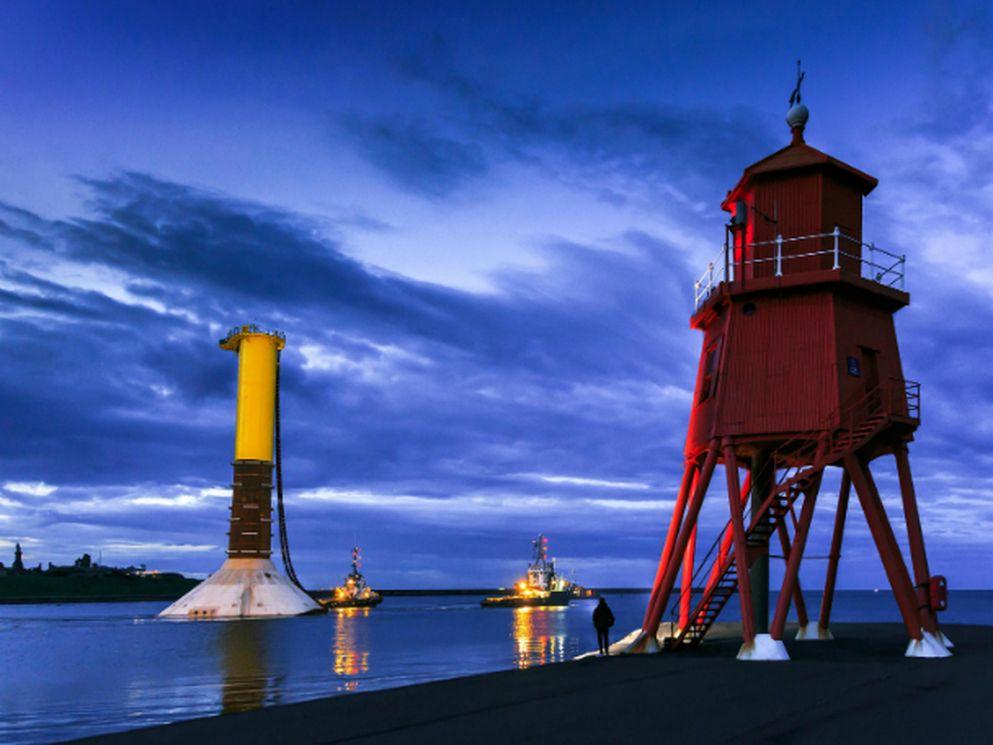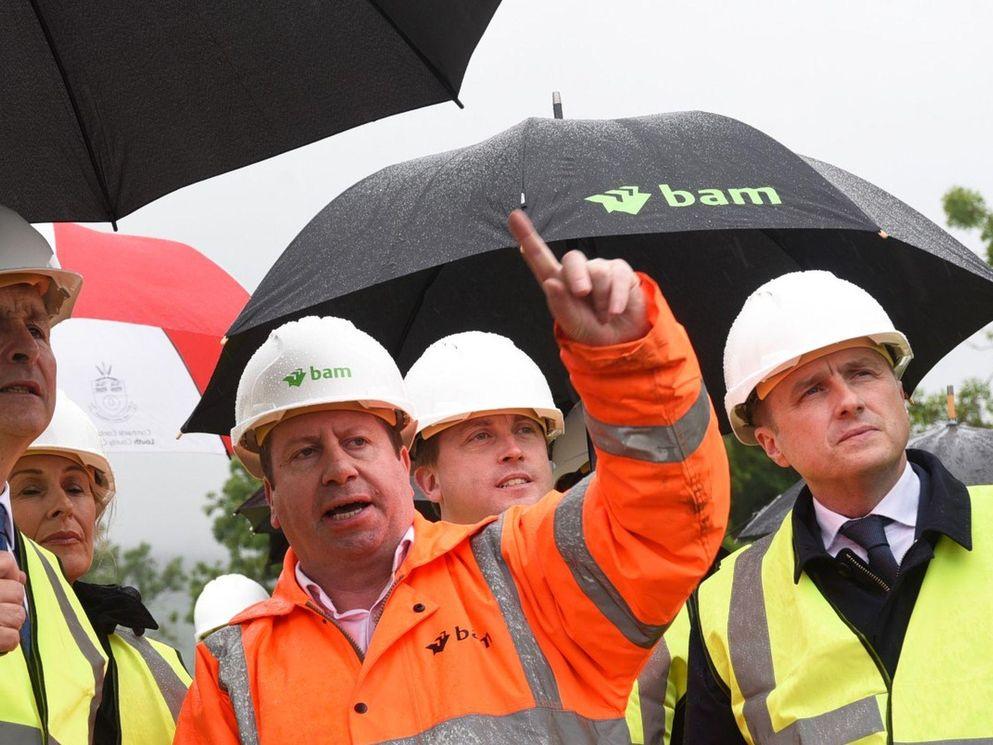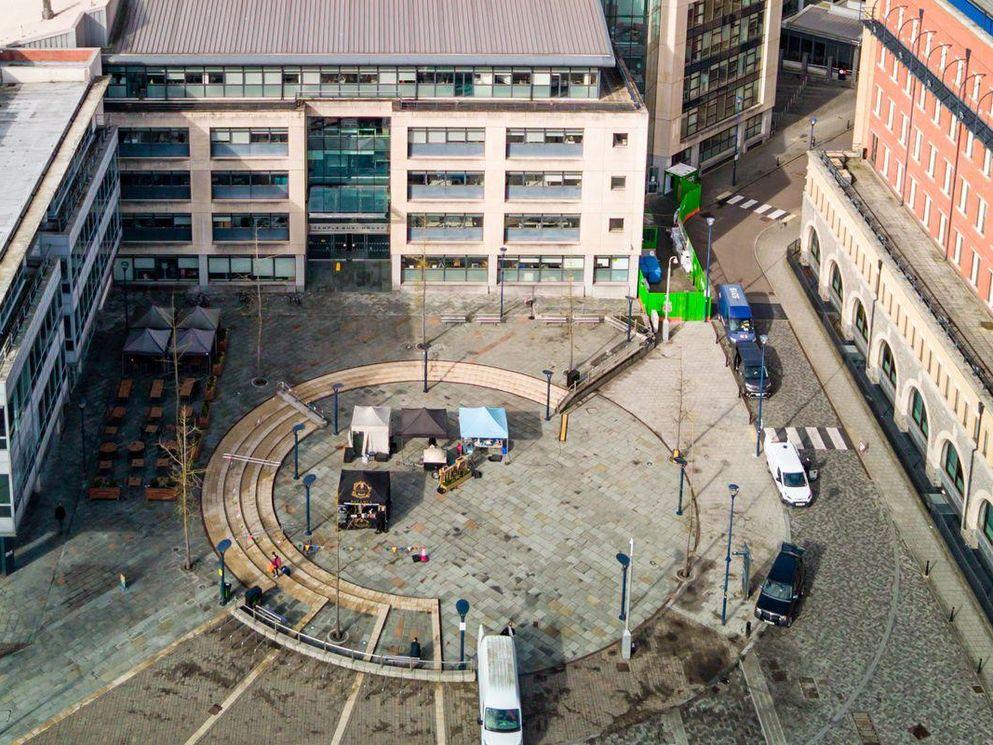Blyth Offshore Demontrator Wind Farm Project: First Gravity Base Foundation lowered onto sea bed

(Press release EDF Energy Renewables:) 31 July 2017 - The first gravity-based foundation (GBF) has been successfully installed onto the sea bed as the latest step in the development of the Blyth Offshore Demonstrator wind farm – the first time this specialist ‘float and submerge’ method has been used on an offshore wind farm.
EDF Energy Renewables is currently building the new wind farm off the Northumberland coast. The project is composed of five wind turbines with a total generating capacity of 41.5MW installed around 6.5km off the coast of Blyth. Once operational, they will generate enough low carbon electricity to power around 34,000 homes*.
Designed and built by Royal BAM Group, the concrete and steel GBFs were constructed in the Neptune dry dock on the Tyne and floated down river to the Port of Tyne where extra ballast was added ahead of their tow out to the offshore site location using three standard tug vessels.
At the offshore site, Strukton is using a specialist vessel to pump sea water into the foundation as ballast to lower it to the prepared sea bed.
Once located correctly in place, the water ballast is replaced with a sand ballast to enable the foundation to rest securely on the sea bed to provide the support structures that act as the foundations for the installation of the wind turbines.
EDF Energy Renewables CEO, Matthieu Hue said: ‘We are delighted to have reached another successful milestone in this ground-breaking project. As well as playing an important role in the generation of low carbon electricity, the Blyth scheme is playing a fundamental role in the in the investigation and testing of new and emerging offshore wind farm installation methods and technologies. As a result, this has been a complex and highly innovative project, but to have successfully reached this latest important stage is very satisfying and work will now progress towards completion of the project in the coming months.’
Each GBF is made up of more than 1,800m3 of concrete and weighs over 15,000 tonnes when fully installed on the seabed. The structures have a total height of around 60 metres from the base to the access platform.
Once all five GBFs are put into position in the coming weeks, specialist contractor VBMS will start laying the special 66kV inter array and export cables that will connect the wind farm to the new substation being constructed at Blyth.
Five MHI Vestas V164 turbines will then be installed onto the GBFs. The turbines will have a power rating of 8.3MW – the largest to be used on an offshore wind farm. It is anticipated that the turbines will start generating power by the end of the year.
Gareth Farrier, Divisional Director, BAM Nuttall, said: ‘BAM is extremely proud to have successfully demonstrated our gravity base foundations in collaboration with EDF Energy Renewables. The successful first immersion of the structure off the coast at Blyth is the highlight of a very intense period of work, where the whole team has worked extremely hard to attain this significant achievement.’
Wholly owned by EDF Energies Nouvelles, the Blyth Offshore Demonstrator project is being built by EDF Energy Renewables, a 50-50 UK joint venture between EDF Energies Nouvelles and EDF Energy. The wind farm will be EDF Energy Renewables’ second offshore wind farm construction following the Teesside wind farm off the North East coast at Redcar.
*41.5MW installed x 0.369 offshore average load factor (a) x 8760 hours, divided by 3.938MWh annual domestic energy consumption per home(b)
(a) Digest of United Kingdom energy statistics 2016, DBEIS, July 2016.
(b) Energy consumption in the UK, DBEIS, November 2016.
Blyth Offshore Demonstrator Wind Farm – key facts:
- The Blyth Offshore Demonstrator project will produce enough low-carbon electricity to power approximately 34,000 UK households
- It will save around 57,600 tonnes of CO2 emissions each year
- It will be the first offshore wind project to connect using 66kv rated cables
- It will be the first time that a “float and submerge” gravity based foundation is used for offshore wind turbines
- Each gravity based foundation will weigh more than 15,000 tonnes when fully installed
- 8.0MW wind turbines with a power mode uprating them to 8.3MW will be installed
About EDF Energy Renewables:
EDF Energy Renewables is one of the UK’s leading renewable energy companies which develops, builds and operates generation projects with a focus on onshore and offshore wind as well as battery storage technology. The company already operates more than 696MW of wind farms and has more than 1GW in development.
The company employs more than 150 people. It is a 50:50 Joint Venture between EDF Energy and EDF Energies Nouvelles.



